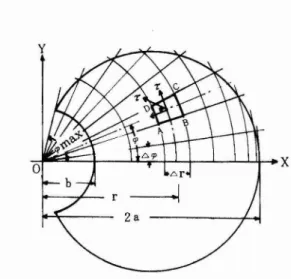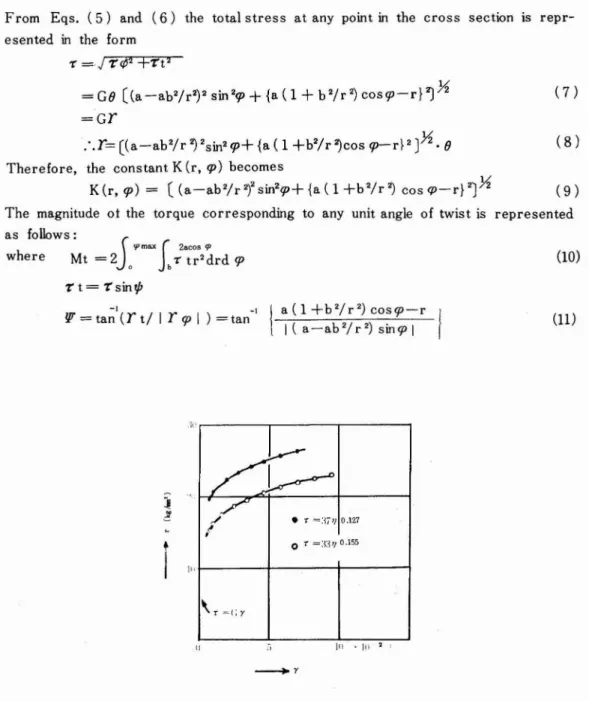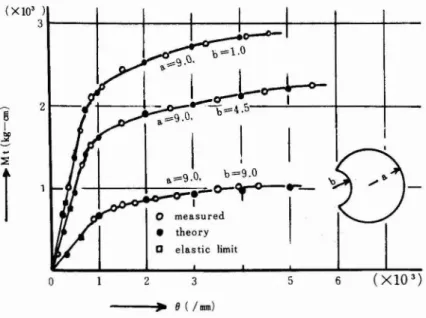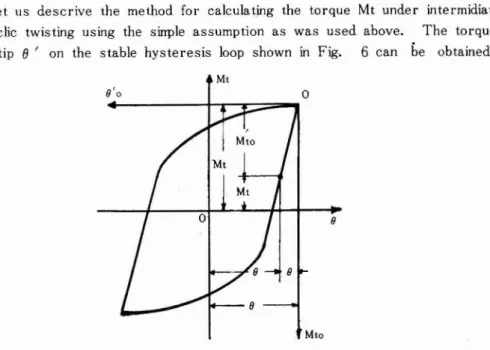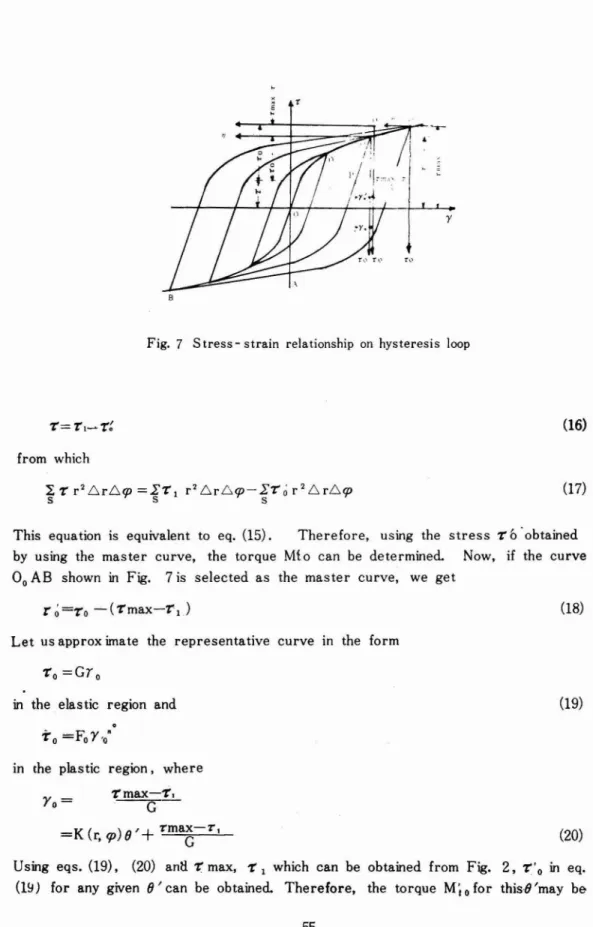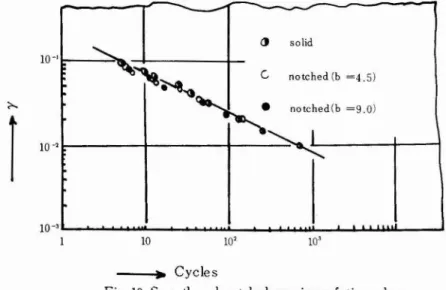Title
On the Low Cycle Fatigue Life of Notched Specimens
Author(s)
Kaneshiro, Hideo
Citation
琉球大学理工学部紀要 工学篇(4): 49-58
Issue Date
1971-04
URL
http://hdl.handle.net/20.500.12000/24011
On the Low Cycle Fatigue Life of Notched Specimens
Hideo KANESHIRO*
I n this paper the fatigue life and the torque vs angle of twist rela-tion ship of a shaft with one semi-circular longitudinal grove were in-vestigated for establishing the simple rule which is valuable for estimating low-cycle fatigue life using the least amount of information on the strength of a material.
The form of a notch and the torsional loading were selected for making the mathematical treatment easier and for letting the e?,periment simpler. The torque-angle of twist relation ship of notched specimens under
mo-\
notonic or cyclic loading were obtained mathematically and the result was compared with the experiment on aluminum alloy (A 384- T 4 by Japanese I ndu s trial Standard).
On the other hand, by comparing the fatigue life of notched and smooth specimens the adequancy of the assumption used was also investigated. The investigation shows that the assumption on strain distribution makes the simple estimation of fatigue life and the estimation of stress distri-bution possible in case of torsional low-cycle fatigue of a shaft with a longitudinal groove.
I. Introduction
The fatigue fracture of machines, airplanes and structures sometimes occures at the notch root under high strain repetition. For this reasion the fatigue problem un-der high strain repetitions has become much interested in recent years. In traditio-nal wor~__ of notched members which are subjected to high strain repetitions, howe-ver, it has been investigated in such a way as experimental data are deduced as si-mple as possible without regarding the mechanics of strain cycling.
In this paper the prediction of the fatigue life of notched members using the least-amount of information on the strength of a material and using a simple assumption on strain distribution has been made. In this paper it is intended to clarify the followin-gs:
( 1) Calculating the nonlinear stress distribution of longitudinally notched bar un-der monotonic or cyclic tWlstmg.
(2) Establishing the method that predicts the fatigue life of plastically stressed notched specimens using the fatigue data of plain specimens.
2. Torque-Angle of Twist Relationship of a Shaft with One Semi-Circular Longitudinal Groove under Static Loading
In this paper the torsional problem in the elastic-plastic state was analyzed by u-sing a simple assumption: shearing strain on the cross section is proportional to an
-Received: Dec. 1 5, 1 970
KANESHIRO: 00 the Low Cycle Fatigue Life Wotched Specimens
angle of twist per unit length
Y
=
K (r, <p) •(J (1)'Where the proportional constant K (r, rp)is assumed to be only a function of coordin-ates and not that of the material used. Namely it is assumed to be the same as ela-stic one even if the specimen deforms plaela-stically. This means K (r, rp) can be dete-mined from the elastic solution. The stress at any point in the cross section can be calculated easily using this assumption and the stress- strain relationship of mater-ial Followingly the torque applied- to the notched member can be simply determined. The comparison of the experimenially obtained results with the torque- angle of twi-st relationship obtained by this method helps to make sure the adequancy of the as-sumption.
Fig. 1 Cross section of notched specimen
In case of the torsional problem of a shaft with one semicircular longitudinal groove the constant K (r, rp) can be determined as follows. According to the theory of ela-sticity, the stress function '" of the torsional problem must satisfy the following eq-uation
a
2 '"1
a",1
a
2 '"a- 2
+ -
a-
+-2a-
2=-2C8
r r r r rpat every point in the cross section and
'" =
0(2)
(3 )
on the boundary of cross section. By reference to Weber's theory eqs. (2) and ( 3) are satisfied by taking the stress function of the form1 )
Bull. Sciences &Engineering Div. Univ of the Ryukyus (Engineering) G8
2
(r~b2) (1-2acos<p/r) (4 )Therefore, the shearing stress '(<p in the radial direction and the shearing stress '(t in the tangential direction became respectively as follows:
'(rp =
l-
a¢> =G8 (a-ab 2/r 2) sin<p (5)r
a
<pa/
' ( t = - - =G8 {a(1+b2/r 2)-r}
ar
From Eqs. (5) and (6) the total stress at any point in the cross section is repr-esented in the form
'r'
=J
'(¢2+'(t2=G8 (a-ab2/r 2)2sin 2<p+{a(l + b 2/r 2) cos<p-d2] >'2' (7)
=Gr
: 1= (a-ab 2/ r 2) 2sin2<p+{a ( 1 +b2/r 2)cos<p-r}2)>'2' • 8 (8 )
Therefore, the constant K (r,<p) becomes
K(r,<p) = (a-ab2/r2tsin2<p+{a(l+b2/r2) coscp-r}2)>'2' (9)
The magnitude ot the torque corresponding as follows:
5
<pmax ( 2.cos 'P where Mt =2 0 Jb'r'tr2drd <p'( t= '(sin'"
to any unit angle of twist is represented
(0)
-I _I
1JT'= tan
(r
t /I
r
<pI )
= tan a (1 +b 2/r 2) cos<p-rI(a-ab 2/r 2) sin<pI (11) ::".---.---,---., • r =:li'/ 0.127 o r =:1:J1/0.155 -/
I
I".---+----+----j
"I'I-+~---,.~+_---+----lr
'r
=I;Y III .HI 2 l-Y
Fig. 2 Monotonic and cyclic stress strain curves for aluminum alloy (A 3B 4-T 4)
KANESHIRO: On the Low Cycle Fatigue Life Watched Specimens
The stress strain diagram obtained from monotonic torsion tests of solid shaft sp-ecimens can be represented in the form
T'
=Gr
(12)
in the elastic region and
(T'
=
Fr
n ) (13)in the plastic region.
F or aluminum alloy (A 3 B 4 - T 4) used in our experiments the values of
F=33.0kg/lllllf. n=0.155, G=2725.0kg/m
were obtained and the stress- strain diagram is shown in Fig. 2. The strain
r
for any unit angle of twist can be obtained from ea. (8) and the stress-r
in the elastic and plastic regions corresponding to this
r
can be obtained from eq. (12) and (13). since the component T't in the tangential direction of-r
can be ob-tained from eq. (ll), the torque Mt applied to the notched member can be obtam ed by integrating eq. (10) over the whole cross section. To obtained numerical va-lue of the torque Mt by digital computer. the cross section was divided into smaller parts as shown in Fig. I. Since the torque about the point 0 by the shearing for-ce acting on the small element ABeD is equal to .6M= T't r26 r6 <p, eq. (10) can
be represented approximately as
Mt::::X 6Mt
s (14)
Where S is the area of the cross section of the notched member.
Fig. (1) shows experimental results and culculated values obtained by using
6 5
I
Ia.-o-~_
13-3 theory elastic limit 2o
2 (Xto' ) 3t---~--+---+---+--+---+----+---~~~ 8 ( / DUn)Bull. Sciences &.Engineering Div. Univ of the Ryukyus (Engineering)
eq. (14). This figure show; that the values calculated for three uifferent notch radii give a very good agreement with experimentally obtained results.
3. Torque-Angle of T wist Relationship of a Shaft with One Semi-Circular Longitudin-nal Groove under Cyclic Loading
A group of stable hysteresis loops obtained by fatigue test of solid shaft speci-mens under constant strain amplitude is shown in Fig. (4). The cyclic stress-strain
-8
-30
Fig. 4 A group of hysteresis loops obtained from torsional test of solid shafts diagram shown in Fig. 2 was obtained by combining together the tips of the companion hysteresis loops in the figure.
'When the notched specimen made of aluminum alloy(A3B4-T4) is subjected to the repeated torsional loading under constant strain amplitude, it hardens initially and is stabilized after some number of cycles when the stable hysteresis loop can be obtained. In Fig. 5 it is shown that the calculated cyclic Mt-B relationship determined
(x10'.'
31---j---j---t---t---t-e
o measure~ ~•
theory i-8
I
~;:, _ 8 ( / . )KANESHI RO: On the Low Cycle Fatigue Life Wotched Specimens
. as a locus of the tips on the stable hysteresis loops Ilnd the experimental results agreed quite well. For obtaining the calculated Mt-{1 relationship of notched speci-mens the cyclic stress- strain diagram of the plain specispeci-mens was used.
Now, let us descrive the method for calculating the torque Mt under intermidiate stage of cyclic twisting using the sinple assumption as was used above. The torque MtI of any tip
e'
on the stable hysteresis loop shown in Fig. 6 can be obtainedIJ'0
Mt
o
Mto
IJ
Fig. 6 Schematic figure of a hystersis loop
from the above-mentioned calculation for the cyclic twisting. If the notched member is twisted only {1' in the inverse-direction from the point 0' to the point P, the following relation is obtained.
(15) Therefore, the experimental values of the torque Mt. are the same quantltl~s as those subtracted Mfo from Mti. After all, we have only to calculate the torque Mfa for a given unit angle of twist {1' in the inverse-direction. When the notched member is twisted only {1' in the inverse-direction, every point in its cross section follows each hysteresis loop which is determined at the peak strain value. In order to get t.he numerical result. on twisting moment it is important to express the com-panion loops by a simple mathematical expression. In case of aluminum alloy (A3B4-'1'4) it was found that the hysteresis loops were simply generated by parallel-shifting of a curve. That is, if we move parallel the axis of abscissa of all hysteresis loops as shown in Fig. 4 and superpose those curves respectivel~.we notice that all of the
these hysteresis loops show a good agreement and can be approximated by one curve (Say"master curve") as shown in Fig. 8. The torque Mfo can be calculated by using the master curve as follows. When the state of stress-strain of a point in the cross section of the notched specime n changes from the point 0' to the point P corresponding to the change of angle of twist {1' of the specimen as shown in Fig. 7, the following is obtained.
Bull. Sciences &Engineering Div. Univ of the Ryukyus (Engineering)
B
Fig. 7 Stress - strain relationship on hysteresis loop
(16) from which
(17)
This equation is equivalent to eq. (15). Therefore, using the stress T'<> -obtained
by using the master curve, the torque Mfo can be determined. Now, if the curve
00AB shown in Fig. 7is selected as the master curve, we get
r~=T'o-(T'max-l"l)
Let us approx imate the representative curve in the form T'o=Gr o
in the elastic region and
.
i"
0=FoY'o'in the plastic region, where
(18)
(19)
Yo
=
T'max-T',G
=K(r,<p)O'+
rmaC-r,
(20)Using eqs. (19), (20) ana
T'.
max, 'r'1 which can be obtained from Fig. 2, 'r" 0 in eq.(IY) for any given 0' can be obtained. Therefore, the torque M;0for this0 'may be
KANESHl RO: On the Low Cycle Fatigue Life Wtched Specimens
.obtained by the numerical integration. Fig. 9 shows experimental results and cal culated values obtained by using the representative approximate curve shown in Fig. 8. They give a good agreement.
60 50 40 ~~ 30
"-i
..,
....
I:'t
2010,-
-r
fo-•
± 1.6X 10-'..
±3.1XlO-' 0 ±4. 7X 10-'•
±6.2XlO-' D ±7.ax
10-'o
.
4a
12 16 (X10') Fig. 8 Characteristic of hysteresis loops-
Ii XlO',.-o.~
~veL--V
2 II•
~t
I
1!
-,
I
il
I.f
-4.
-3 :-2,
-1 0 I1
3,(x,,-',
a
-+8(/IlIIl)/
-1~
0o
measured • theory-
/0
II
or
.-2"6
~·r~
1,.I
I
Bull. Sciences & Engineering Div. Univ of the Ryukyus (Engineering)
4· Torsion Fatigue Test of Notched Members under Constant Strain Amplitude
Fig. 10 shows the strain amplitude vs the numbe r of cycles relationship under constant twisting amplitude zero mean cycling. The number of cycles was determin-ed when the crack length reachdetermin-ed up to 3 - 5mm. S train of notched specime ns in this figure represent those at the notch root calculated by using the assumption. The results of notched specimens in torsional fatigue test are slightly lower than
10' 10' 10
-(J solid
'~
~~
C notched (b =4.5)~~
notched(b =9.0)~
10-' Ir
10' ---i"~ CyclesFig. 10 Smooth and notched specimen fatigue data
those of plain specimens. It is perhaps the main reasons that the one is that the strain quantity at the notch root is more difficult than that of smooth specimen. we conclusively say that our assumption is apparently the first order good approximation for predicting the fatigue life of notched menbers from plain specimen fatigue data and good enough for usual engineering purpose.
5.
ConclusionTo estimate the low cycle fatigue life of notched members in consideration of the strain hardening property of a material, the notch effect was investigated on the shaft with a semi-circular longitudinal groove by using the simple assumption on the strain distribution. The following conclusions were obtained.
(1) Experimental results and calculated values of the monotonic torque-angle ot twist relationship gave a good agreement, especially in case of small notch. (2) Experimental results and calculated values of the cyclic torque-angle of twist
relationship gave a good agreement.
(3) Experimental results and calculated values of the torque at the intermidiate state of loading also give a good agrement
(4) The fatigue life of notched members can be predicted from smooth specimen fatigue data using the simple assumption on strain distribution.
KANESHIRO: On the Low Cycle Fatigue Life Watched Specimens
6. References References
(1) Timoshenko and Goodier ~Theory of Elasticity~ Mcgraw-Hill Book Co, New
York, 'p268
(2) H. Kaneshiro, ~A Study on the Shearing Stress in the Surface La 6!r of
Circular Solid Specimens under CydJic Torsion~, Bulletin of the Kyushu
